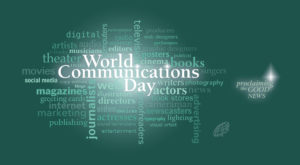 This weekend is a special moment for the Catholic Church. It is the 50th World Communications Day. We have these special collections each year for this essential component of the Catholic Church, but what does it really mean? Why do we focus every year on the need to communicate our faith in a tangible way? World Communications Day stems from one of the decrees of the Second Vatican Council, Inter mirifica (“The Means of Social Communication”). Initially focused on the press and media outlets like movies and TV, it has expanded to mean all types of communication, from verbal to written, electronic or paper, video and pictures. If you think about how meaningful “communication” is for you and your life, you can understand why our Church puts such a special emphasis on communication.
This weekend is a special moment for the Catholic Church. It is the 50th World Communications Day. We have these special collections each year for this essential component of the Catholic Church, but what does it really mean? Why do we focus every year on the need to communicate our faith in a tangible way? World Communications Day stems from one of the decrees of the Second Vatican Council, Inter mirifica (“The Means of Social Communication”). Initially focused on the press and media outlets like movies and TV, it has expanded to mean all types of communication, from verbal to written, electronic or paper, video and pictures. If you think about how meaningful “communication” is for you and your life, you can understand why our Church puts such a special emphasis on communication.
Our Holy Father, in his message for this weekend, clearly lays out the need to communicate to every single person on the planet in a loving and merciful way:
As sons and daughters of God, we are called to communicate with everyone, without exception. In a particular way, the Church’s words and actions are all meant to convey mercy, to touch people’s hearts and to sustain them on their journey to that fullness of life which Jesus Christ was sent by the Father to bring to all. This means that we ourselves must be willing to accept the warmth of Mother Church and to share that warmth with others, so that Jesus may be known and loved. That warmth is what gives substance to the word of faith; by our preaching and witness, it ignites the “spark” which gives them life.
Communication has the power to build bridges, to enable encounter and inclusion, and thus to enrich society. How beautiful it is when people select their words and actions with care, in the effort to avoid misunderstandings, to heal wounded memories and to build peace and harmony. Words can build bridges between individuals and within families, social groups and peoples. This is possible both in the material world and the digital world. Our words and actions should be such as to help us all escape the vicious circles of condemnation and vengeance which continue to ensnare individuals and nations, encouraging expressions of hatred. The words of Christians ought to be a constant encouragement to communion and, even in those cases where they must firmly condemn evil, they should never try to rupture relationships and communication.
For this reason, I would like to invite all people of good will to rediscover the power of mercy to heal wounded relationships and to restore peace and harmony to families and communities. All of us know how many ways ancient wounds and lingering resentments can entrap individuals and stand in the way of communication and reconciliation. The same holds true for relationships between peoples. In every case, mercy is able to create a new kind of speech and dialogue. Shakespeare put it eloquently when he said: “The quality of mercy is not strained. It droppeth as the gentle rain from heaven upon the place beneath. It is twice blessed: it blesseth him that gives and him that takes” (The Merchant of Venice, Act IV, Scene I).
How does that translate here at St. John? The best way I can think of is a story I wrote a few years ago, about how we treat a butterfly, the moment of encounter that may take place at the front of the church, or at the grocery store, or even in our own homes.
 When a butterfly lands on our hand, we have several possible reactions to it, just like when we are called into a moment of encounter with another person. We could be so shocked of the beauty of that butterfly that we freeze, and do not move. We are passive. The butterfly will soon fly away to find more fertile ground. Or, we could be so scared to lose the butterfly that we close our hands around it, possibly hurting it in our attempt to keep it just where we want it to be. If we did not hurt it, the butterfly will find a way out between our fingers and fly away, as frightened as we were to lose it. We will have scared it away by trying to contain it, or put rules around it. Or, we could nurture and respect the butterfly so much, that we simply put our other hand up to protect it from the buffering wind around us, creating a safe place for it to sit. The butterfly will stay with us, calmed and sheltered.
When a butterfly lands on our hand, we have several possible reactions to it, just like when we are called into a moment of encounter with another person. We could be so shocked of the beauty of that butterfly that we freeze, and do not move. We are passive. The butterfly will soon fly away to find more fertile ground. Or, we could be so scared to lose the butterfly that we close our hands around it, possibly hurting it in our attempt to keep it just where we want it to be. If we did not hurt it, the butterfly will find a way out between our fingers and fly away, as frightened as we were to lose it. We will have scared it away by trying to contain it, or put rules around it. Or, we could nurture and respect the butterfly so much, that we simply put our other hand up to protect it from the buffering wind around us, creating a safe place for it to sit. The butterfly will stay with us, calmed and sheltered.
Let us make Saint John that safe, loving, joyous place where any butterfly can find peace, love, mercy, and fellowship.
